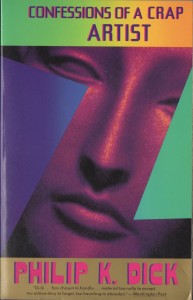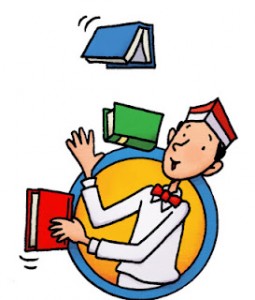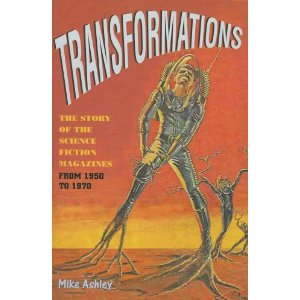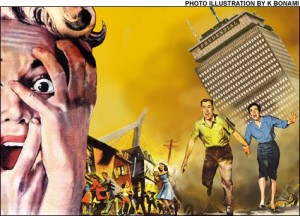I apologize that it’s taken me the better part of a week to put my impressions of Capclave 2011 down in pixels. I really meant to get to this early in the week, but other topics kept popping up. Better late than never, I suppose.
All in all, Capclave 2011 was another in a long string of well-run, thoughtfully programmed conventions from the folks whose motto is, “Where reading is not extinct” (as opposed to many current larger conventions, which tend to bear out Barry Malzberg’s frequently and sadly repeated quip that “today, science fiction is a minor special interest at most science fiction conventions”).
The dealers’ room was especially well stocked with books vendors this year. I heard from one of the con organizers that some of their teeshirt and miscellaneous merchandise merchants had to cancel at the last minute, so books dealers on the wait list filled in the gaps. I had no complaints; I could have spent a lot more than I did (only thoughts of the Wrath of the Spouse kept my fingers out of my wallet). My favorite purchase was Mike Ashley’s Transformations: the Story of the Science Fiction Magazines from 1950 to 1970. This volume is a revision and combination of the latter two of the four books on the history of the science fiction magazine that Mike published in the 1970s. I was a teenager when they first came out, and I have the first two books on my shelf, the ones that cover 1926 through 1946. I’m really looking forward to reading Transformations. The book covers two of the most tumultuous and varied decades in the development of the science fiction magazine, including the “Death of Science Fiction” period of the late 1950s and early 1960s (which I’ve blogged about in another article) that followed the breaking up of the American News Company in 1958. In a lot of ways, the situation of the science fiction field during portions of the two decades covered in Transformations mirrors the state of the field today, with publishers and editors struggling to stay relevant/solvent and writers watching their markets shrink or disappear and worrying obsessively about what might come five years down the road — or five months down the road.
Fittingly, the first panel I attended on Saturday was “Will Books Survive–And in What Form?” which featured Iver Cooper, David Hartwell, Ernest Lilley, Jamie Todd Rubin, and Elaine Stiles. I was a little disappointed that the panel wasn’t more balanced in terms of outlook; with the exception of Jamie Todd Rubin, the other panelists predominately shared the “grumpy old reader” opinion that I hate reading long texts on screens, it hurts my eyes, I’m sure lots of people feel this way, therefore traditional books shall not vanish from the earth. It’s certainly a defensible point of view — I share it myself, to an extent — but I had hoped to listen to a bit more variety of opinion. The most interesting info tidbit I picked up came from David Hartwell of Tor Books, who said that by far the most enthusiastic adopters of e-reading devices to date have been readers of romance novels, because most of these readers (a) read an awful lot of romance novels, and (b) tend not to physically keep their books. Prior to the rise of the Kindle and Nook, a majority of romance readers traded in their novels as soon as they were done with them at their local paperback exchange. Now, I suppose they can just delete them from their devices’ memories. A question not addressed by the panel until five minutes before the end was the corollary question to “Will Books Survive?” which is, “Will Reading Survive?” The panelist barely had time to begin speaking to this larger issue before we were ushered from the room.
I had meant to next attend a panel on the stories of Murray Leinster, but I ran into an editor acquaintance of mine who asked me to accompany him back to the dealers’ room so we could talk. This is a gentleman who had recently given lengthy consideration at one of the major SF houses to one of my novels, Ghostlands, but who had ultimately decided not to acquire the book. He (very graciously, I should add) ended up giving me a peek behind the curtain at the rather ugly sausage-making of publishing, wanting to explain to me why he had ended up passing on my book despite having liked it a great deal. He said that my novel was simply too complicated to easily boil down to a marketing pitch. Neither he nor the other editors he had shared the book with had been able to come up with a way to sell the book internally to their P&L (Profit and Loss) managers and sales staff, to describe the book in three easy sentences so the sales staff could then push the book to clients using two easy sentences.
He told me, “Twenty-five or thirty years ago, I would’ve had no hesitation whatsoever putting your book out as a paperback original. It reminds me a lot of what Philip Jose Farmer and Norman Spinrad were doing back then.” Today, however, he would have difficulty publishing many of the works of those two seminal SF authors. “Philip Jose Farmer would come out with one really popular book, and then he would do four or five that hardly anybody wanted to read, because they were more challenging or obscure. He could get away with that back then. Nobody can get away with that now.” He explained (and I knew much of this, having lived those earlier book buying days as a teenager) that in the 1970s the distribution system for books was entirely different from that which prevails today. Back then, millions of paperbacks were sold through convenience stores, drugstores, cigar shops, newsstands, and department stores. Buyers for those markets typically only concerned themselves with the covers of the books; “I was able to sneak through some pretty challenging, unconventional novels back then,” my editor friend told me, “so long as they had a cover illustration of a spaceship or bug-eyed monster.” Now, buyers for major markets (which are far more concentrated than they once were) want to purchase fiction that is easily classifiable and has an easily grasped “marketing hook” (which essentially boils down to a similarity to other books which have recently sold well). This was a very bittersweet conversation for me, as you might imagine. I was deeply honored and touched to have this longtime professional compare my book to works by Philip Jose Farmer and Norman Spinrad, writers I’ve long revered. And yet at the same time, he was telling me, “You could’ve been a contender – thirty years ago.”
After I grabbed some dinner, the next panel I attended was “Making Fictional Cities Come Alive” with John Ashmead, Laura Anne Gilman, James Morrow, and Michael Swanwick. My two big takeaways from this panel were: (1) Michael Swanwick is a marvelous teller of tales, a gentle, insightful man who can make an audience laugh without seeming to try; and (2) boy, are most of these panelists down on the suburbs. It shouldn’t be surprising that panelists who volunteer to speak about creating fictional cities would be great proponents of city life and city living. What did surprise me a bit and disappoint me was that they should be so vehement in their disdain for suburbs and suburban life, the life that the great majority of their countrymen have either chosen or found themselves consigned to by circumstances. It came across as a sort of appalling snobbery. I’ll admit I once felt that way about the suburbs myself, when I was a teenager and a college student, and during much of the time I spent as a bachelor in New Orleans. City life has definite advantages for single people, and living out in the ‘burbs can be a horror show if you are single (been there, done that: Long Island, 1987-1990). However, my view on the benefits of suburban life changed a good deal once I had children. There are darn good reasons why the majority of American families with children live in the suburbs. For families with school-age children, the cost-benefit balance of life in a typical suburb is far more favorable than that of life in most large cities. It pained me that a group of science fiction writers, who should be imaginatively attuned to considerations of the varying life needs of different populations (and different species), should have closed their minds so tightly against the possibility that, for some people, indeed, for many people, suburban living is a rational adaptation (and not simply a reflection of hickishness).
James Morrow and his wife Kathy sat next to me at Saturday night’s mass autographing session; Jim remembered that we shared an editor at Tachyon Publications. I was very pleased to have his company, because I’ve admired his work for a long time, particularly Only Begotten Daughter (perhaps one of my most enjoyable reading experiences ever) and his more recent Slouching Towards Hiroshima, a reimagining of the Godzilla mythos which I found absolutely compelling (and also quite funny). Kathy was delightful. When we found ourselves sitting next to each other in the con suite later on, I mentioned to her that, without exception, every writer’s spouse I have had the opportunity to meet has been a super human being, someone I’d be willing to leave my kids with in an emergency without a second thought. Writer’s spouses of my acquaintance who sprang to mind included Joyce Malzberg, Judi Castro, Marty Rowland, Joan Saberhagen, and Jim Lindskold, all absolutely marvelous people, loads of fun and easy to talk with. Seems to me there’s a particular personality type who meshes well with the writerly type.
My first panel Sunday morning was “Mythpunk” with Jonah Knight and Catherynne Valente (Barbara Chepaitis wasn’t able to attend). This ended up being pretty much Cat’s panel, as she invented the term “mythpunk” in a blog post about seven years back. Apart from sharing what I had done with vampyric legends in the two Jules Duchon books and my riffs on trickster and bad luck spirits from various ethnic traditions in The Bad Luck Spirits’ Social Aid and Pleasure Club, I didn’t have a huge amount to add. But Cat had plenty to say, so we didn’t suffer from “dead air.”
My last panel ended up being my most enjoyable of the convention. I moderated “Stealing from the Best,” joined by Alethea Kontis, Sherin Nicole, and Lawrence Watt-Evans. Everybody was in a great mood and full of quips and jokes, and it was an exceedingly easy panel to moderate, as, apart from my throwing out a few questions and observations, it pretty much flowed on its own power. My initial question to the other panelists was whether they more frequently experienced “the agony of influence” (being unable to escape the sense of having been influenced by writers one has read, and dreading the impact this may have on the originality of one’s work) or “the ecstasy of influence” (Jonathan Lethem’s term for the feeling of wonderment a writer can have realizing that he or she is channeling the works of earlier writers he or she has particularly loved). “The ecstasy of influence” won, 4-0. Alethea writes primarily for children, so she spoke about her appropriation of classic fairy tales and seminal YA works such as A Wrinkle in Time. Lawrence talked about his use of The Count of Monte Christo, following the path of Alfred Bester, who modeled his The Stars My Destination on the same classic work. I talked about making liberal use of the works of John Kennedy Toole (for Fat White Vampire Blues), Dashiell Hammett (for Bride of the Fat White Vampire), and Ray Bradbury (for The Good Humor Man, or, Calorie 3501).

Another purchase I made in the dealers’ room was Philip K. Dick’s 1975 mainstream novel, Confessions of a Crap Artist, which Dick wrote in 1959 but wasn’t able to get published for another sixteen years (I feel your pain, Phil, I truly do). I’ve already started reading it, and thus far, it reminds me in some ways of Richard Yates’ 1961 novel Revolutionary Road, which was probably written pretty much contemporaneously with Confessions of a Crap Artist. Both are biting satires of 1950s American suburban married life, with Dick’s book set in the Marin County suburbs of San Francisco and Yates’ novel set in suburban Connecticut. Revolutionary Road was Yates’ first novel and a finalist for the 1962 National Book Award (along with Catch 22 and The Moviegoer); Confessions of a Crap Artist was one of about a dozen non-science fiction novels Dick wrote between 1949 and 1960, and it was the only one of the group to have been published prior to his death. I’ll have to do a bit of searching to find out whether these two particular novels have been critically compared before. If not, I think I have another blog essay ahead.









